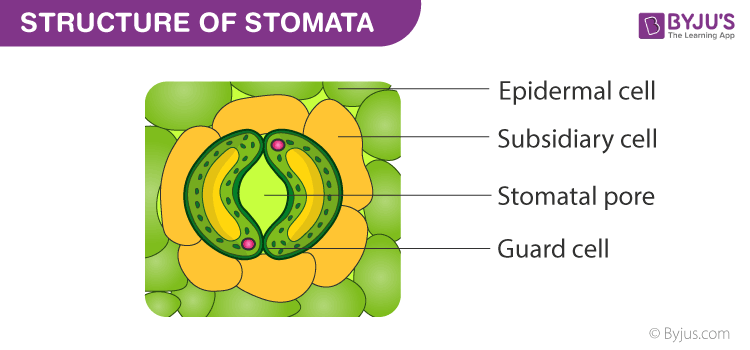There are certain parts in all green plants which are essential and play a critical role in different life processes. Stomata is one of the essential parts that is involved in gaseous exchange. There are thousands of stomata on the surface of the leaves. Most of these are found on the lower side of the leaves.
Table of Contents
What is Stomata?
Types of Stomata
Anomocytic Stomata
Anisocytic Stomata
Diacytic Stomata
Paracytic Stomata
Gramineous Stomata
Structure of Stomata
Functions of Stomata
Opening and Closing of Stomata
In this article, let us explore what stomata is, its types, structure, and functions along with its opening and closing.
What are Stomata?
Stomata are the tiny openings present on the epidermis of leaves. We can see stomata under the light microscope. In some of the plants, stomata are present on stems and other parts of plants. Stomata play an important role in gaseous exchange and photosynthesis. They control by transpiration rate by opening and closing.
Explore more Morphology of Leaves
Types of Stomata
There are different types of stomata and they are mainly classified based on their number and characteristics of the surrounding subsidiary cells. Listed below are the different types of stomata.
Anomocytic Stomata
They are surrounded by epidermal cells, which have a fixed shape and size. The stomata appear to be embedded in epidermal cells. There is no definite number and arrangement of cells surrounding the stomata.
Anisocytic Stomata
Stomata are surrounded by three subsidiary cells having unequal sizes, one is smaller compared to the other two.
Diacytic Stomata
The stomata are surrounded by a pair of subsidiary cells that are perpendicular to the guard cell.
Paracytic Stomata
The stomata are continuously surrounded by two subsidiaries, which are arranged parallel to the stomatal pore and the guard cells.
Gramineous Stomata
Each stoma possesses two guard cells, which are shaped like dumbbells. The subsidiary cells are parallel to the guard cells. The guard cells are found narrow in the middle and wider at the ends.
Structure of Stomata

Structure of Stomata
The stomata consist of minute pores called stoma surrounded by a pair of guard cells. Stomata, open and close according to the turgidity of guard cells. The cell wall surrounding the pore is tough and flexible. The shape of guard cells usually differs in both monocots and dicots, though the mechanism continues to be the same. Guard cells are bean-shaped and contain chloroplasts. They contain chlorophyll and capture light energy.
The subsidiary cells surround the guard cells. They are the accessory cells to guard cells and are found in the epidermis of plants. They are present between guard cells and epidermal cells and protect epidermal cells when the guard cells expand during stomatal opening.
The average number of stomata is about 300 per square mm of the leaf surface.
Also, refer to Distribution of Stomata in the Lower and Upper Surfaces of the Leaves
The table given below explains the total number of stomata present on the upper and lower surfaces of leaves of different plants.
| Total Number of Stomata / mm2 | ||
| Upper Surface | Lower surface | |
| Monocotyledon | ||
| Wheat | 50 | 40 |
| Barley | 70 | 85 |
| Onion | 175 | 175 |
| Dicotyledon | ||
| Sunflower | 120 | 175 |
| Alfalfa | 169 | 188 |
| Geranium | 29 | 179 |
We can conclude that dicots have more stomata on the lower surface, whereas monocots have stomata distributed equally on both the surfaces of leaves.
Functions of Stomata
The main functions of stomata are:
- Gaseous exchange- Stomatal opening and closure help in the gaseous exchange between the plant and surrounding.
- It helps in transpiration and removal of excess water in the form of water vapour.
- Stomatal closure at night prevents water from escaping through pores.
- It maintains the moisture balance according to weather by opening and closing.
- Stomata facilitate carbon dioxide uptake and release of oxygen during the process of photosynthesis.
Opening and Closing of Stomata

The mechanism of stomatal opening and closure
The opening and closing of stomata depend on the turgor pressure, caused by the osmotic flow of water in the guard cells. When the guard cells are turgid, they expand resulting in the opening of stomata. When the guard cells lose water, they become flaccid leading to stomatal closure. Stomata normally open when the light strikes the leaf and close during the night.
Also read-Transpiration
Learn more in detail about what is stomata, its structure, functions and other related topics at BYJU’S Biology
Frequently Asked Questions
Where are stomata found in the plant cells?
In all green plants, stomata are found in the epidermis of leaves, stems, and other parts.
Why do plants need stomata?
Stomata are the specialized pores or openings present in the epidermis of plant cells, which play a crucial role in gaseous exchange during the process of photosynthesis.
What are the Guard Cells?
Two bean-shaped cells surrounding a stoma are called Guard Cells. They play a crucial role during the process of photosynthesis.
Explain the structure of stomata.
Stomata are the tiny, kidney, or bean-shaped pores or openings present in the epidermis of the cell. The stomatal opening has specialized guard cells surrounding them.
List the types of stomata.
There are different types of stomata and are classified based on various criteria:
Based on the structure:
- Paracytic.
- Tetracytic.
- Actinocytic.
- Graminaceous.
- Anisocytic or Cruciferous.
- Diacytic or Caryophyllaceous.
- Anomocytic or Ranunculaceous.
Based on Plant Development:
- Perigynous Type.
- Misogynous Type.
- Mesoperigynous Type.
Based on their distribution or placement of plant leaves:
- Oat Type.
- Potato Type.
- Water Lily Type.
- Potamogeton Type.
- Apple or Mulberry Type.

